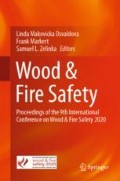Abstract
Wood and wood-based materials are combustible materials. This does not mean, however, that in the event of a fire, the elements made of these materials pose a threat. Separate the flammability from the spread of fire and fire resistance. Contrary to appearances, doors made of wood and wood-based composites obtain good results in the field of fire resistance and constitute an effective barrier for the spread of fire to neighbouring fire zones.
Fire doors play a key role in the fulfilment of fire safety requirement. In fire conditions, they are to form a barrier to fire, smoke and heat. Therefore, this type of elements should be appropriately fire-rated with respect to the fire integrity, fire insulation and smoke control.
This paper presents the main issues related to the fire resistance of timber doorsets. Aspects such as requirements, test methodology and way of classification for this type of elements have been discussed. Moreover, there are shown examples of test result and the conclusions regarding the behaviour of timber fire doors in standard fire scenario, based on many years of researches conducted in the Fire Research Department of Building Research Institute.
Access this chapter
Tax calculation will be finalised at checkout
Purchases are for personal use only
References
Sędłak B, Sulik P (2018) Zachowanie się drzwi stalowych w warunkach pożaru. Mater Bud 7:10–12
Izydorczyk D, Sędłak B, Sulik P (2017) Fire doors in tunnels emergency exits – smoke control and fire resistance tests. In: IFireSS 2017 – 2nd international fire safety symposium, Naples, Italy, 7–9 June 2017, pp 1–8
Wakili KG, Wullschleger L, Hugi E (2008) Thermal behaviour of a steel door frame subjected to the standard fire of ISO 834: measurements, numerical simulation and parameter study. Fire Saf J 43(5):325–333
Izydorczyk D, Sędłak B, Sulik P (2014) Fire resistance of timber doors - part I: test procedure and classification. Ann Warsaw Univ Life Sci SGGW For Wood Technol 86:125–128
Izydorczyk D, Sędłak B, Sulik P (2014) Fire resistance of timber doors - part II: technical solutions and test results. Ann Warsaw Univ Life Sci SGGW For Wood Technol 86:129–132
Laufs W, Luible A (2003) Introduction on use of glass in modern buildings, Rapp. N° ICOM 462
Zhan Y, Xia Z, Xin W, Hai-lun L (2011) Application and integrity evaluation of monolithic fire-resistant glass. Procedia Eng 11:603–607
Wu M, Chow WK, Ni X (2015) Characterization and thermal degradation of protective layers in high-rating fire-resistant glass. Fire Mater 39(1):26–40
Laskowska Z, Borowy A (2015) Szyby w elementach o określonej odporności ogniowej. Świat Szkła 20(12):10–15
Laskowska Z, Borowy A (2016) Szyby zespolone w elementach o określonej odporności ogniowej. Świat Szkła 21(3):15–20, 28
Glass RA, Rubin AI (1979) Fire safety for high-rise buildings, Gaithersburg, MD
Sassi S et al (2016) Fire safety engineering applied to high-rise building facades. In: MATEC web conferences, vol 46, p 04002
Sulik P, Sędłak B, Turkowski P, Węgrzyński W (2014) Bezpieczeństwo pożarowe budynków wysokich i wysokościowych. In: Halicka A (ed) Budownictwo na obszarach zurbanizowanych, Nauka, praktyka, perspektywy. Politechnika Lubelska, pp 105–120
Thomas G (2002) Thermal properties of gypsum plasterboard at high temperatures. Fire Mater 26(1):37–45
Camino G, Lomakin S (2001) Intumescent materials. In: Horrocks AR, Price D (eds) Fire retardant materials. Woodhead Publishing Limited, pp 318–335
EN 13501-2:2016 (2016) Fire classification of construction products and building elements - part 2: classification using data from fire resistance tests, excluding ventilation services
EN 1634-1:2014 + A1:2018 (2018) Fire resistance and smoke control tests for door and shutter assemblies, openable windows and elements of building hardware - part 1: fire resistance test for door and shutter assemblies and openable windows
EN 1363-2:1999 (1999) Fire resistance tests. Alternative and additional procedures
Izydorczyk D, Sędłak B, Papis B, Turkowski P (2017) Doors with specific fire resistance class. Procedia Eng 172:417–425
Borowy A (2014) Fire resistance testing of glazed building elements. In: POŽÁRNÍ OCHRANA 2014, pp 15–17
Kinowski J, Sędłak B, Sulik P, Izydorczyk D (2016) Fire resistance glazed constructions classification, changes in the field of application. Appl Struct Fire Eng
Izydorczyk D, Sȩdłak B, Sulik P (2017) Thermal insulation of single leaf fire doors: test results comparison in standard temperature-time fire scenario for different types of doorsets. Appl Struct Fire Eng
Izydorczyk D, Sędłak B, Sulik P (2016) Izolacyjność ogniowa drzwi przeciwpożarowych. Izolacje 21(1):52–63
Sulik P, Izydorczyk D, Sędłak B (2016) Bezinwazyjna weryfikacja poprawności wykonania i montażu drzwi przeciwpożarowych. In: Problemy techniczno-prawne utrzymania obiektów budowlanych: Ogólnopolska konferencja, Warszawa, 22–23 January 2016, pp 147–150
Izydorczyk D, Sędłak B, Sulik P (2014) Problematyka prawidłowego odbioru wybranych oddzieleń przeciwpożarowych. Mater Bud 11(11):62–64
Sulik P, Izydorczyk D, Sędłak B (2015) Elementy decydujące o awariach wybranych oddzieleń przeciwpożarowych. In: XXVII Konferencja Naukowo-Techniczna Awarie Budowlane, Szczecin, Międzyzdroje, pp 771–778
Sulik P, Sędłak B (2015) Prawidłowy odbiór przeszklonych drzwi przeciwpożarowych. Świat Szkła 20(2):46–49, 56
Author information
Authors and Affiliations
Corresponding author
Editor information
Editors and Affiliations
Rights and permissions
Copyright information
© 2020 Springer Nature Switzerland AG
About this paper
Cite this paper
Sędłak, B., Sulik, P., Izydorczyk, D. (2020). Behaviour of Timber Doors in Fire Conditions. In: Makovicka Osvaldova, L., Markert, F., Zelinka, S. (eds) Wood & Fire Safety. WFS 2020. Springer, Cham. https://doi.org/10.1007/978-3-030-41235-7_23
Download citation
DOI: https://doi.org/10.1007/978-3-030-41235-7_23
Published:
Publisher Name: Springer, Cham
Print ISBN: 978-3-030-41234-0
Online ISBN: 978-3-030-41235-7
eBook Packages: EngineeringEngineering (R0)

